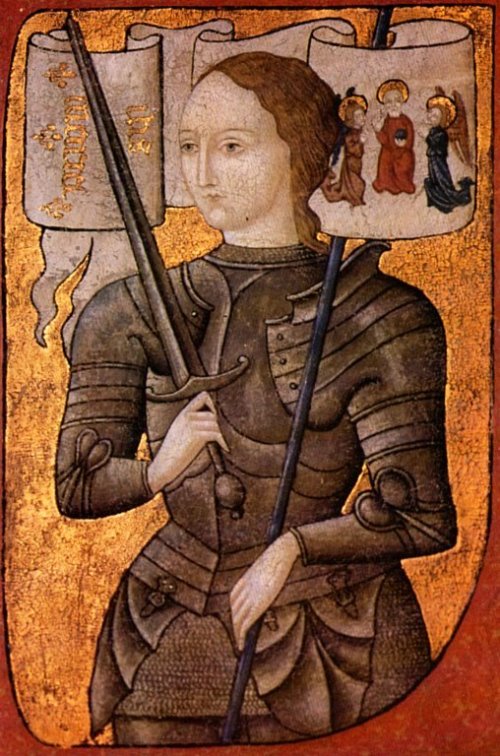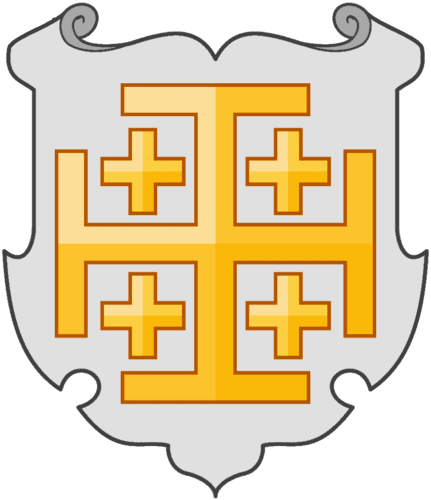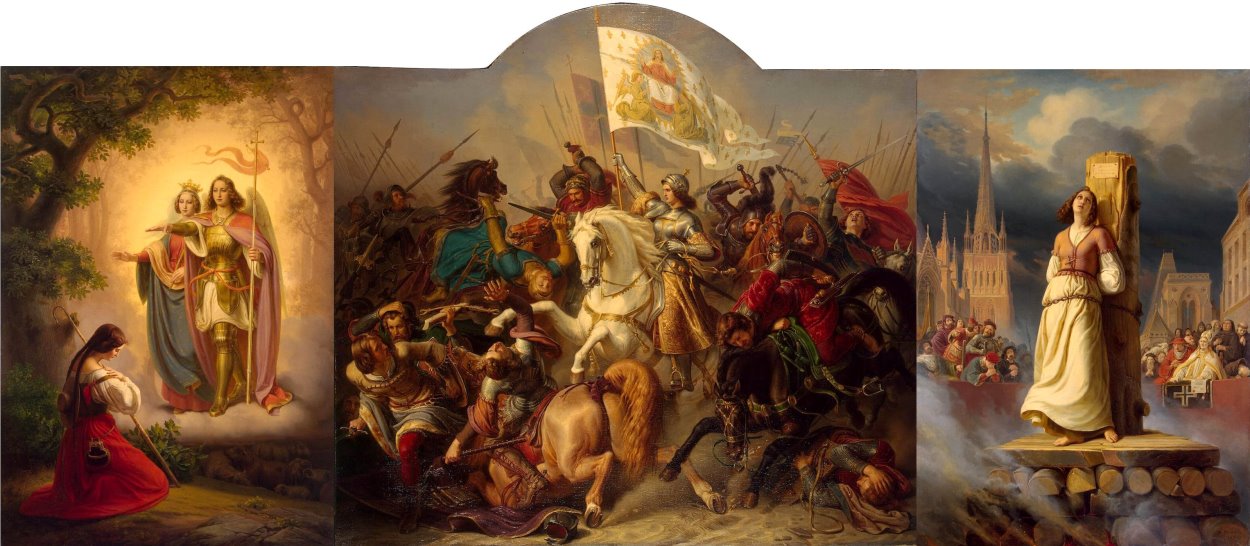 Saint Joan of Arc (1412-1431 AD) is one of the most famous historical figures of chivalric knighthood in human history, with a real-life story of a Holy quest, driven by Mystic divine visions and prophecies, and the purest of devoted faith within the Church, combined with astonishingly superior military prowess which resulted in major victories.
Saint Joan of Arc (1412-1431 AD) is one of the most famous historical figures of chivalric knighthood in human history, with a real-life story of a Holy quest, driven by Mystic divine visions and prophecies, and the purest of devoted faith within the Church, combined with astonishingly superior military prowess which resulted in major victories.
Little known facts documented in the historical record (presented here) prove that Joan of Arc herself was a real hereditary Templar, knowingly and purposefully continuing the living tradition of the Order of the Temple of Solomon.
Just as the true history of Mary Magdalene proves that women can be religious leaders, the true history of Joan of Arc proves that women can be monastic warriors in their own right, on equal footing with men as their counterparts.
These historical precedents, which are further supported by traditional doctrines and teachings of the Knights Templar, irrevocably establish that the Order welcomes and encourages the full participation of women, whether as Clergy, supporting Adjutantes (female Sergeants), or Dames (female Knights).
 Notre Dame Cathedral in Paris, constructed by the Knights Templar (1163-1250 AD), features a statue of Joan of Arc (added ca. 1440 AD), which portrays her with some indications of her own Templar affiliations. This iconic statue shows her with a distinctly proper Templar sword, in the original 12th century form, which is markedly different from the French swords used during her time. Her battle flag is mounted on the lance in a manner reflecting the Agnus Dei seal of the Templar Grand Mastery.
Notre Dame Cathedral in Paris, constructed by the Knights Templar (1163-1250 AD), features a statue of Joan of Arc (added ca. 1440 AD), which portrays her with some indications of her own Templar affiliations. This iconic statue shows her with a distinctly proper Templar sword, in the original 12th century form, which is markedly different from the French swords used during her time. Her battle flag is mounted on the lance in a manner reflecting the Agnus Dei seal of the Templar Grand Mastery.
Her statue also shows a pouch hanging from her belt, mirroring the Templar iconographic “money pouch” traditionally depicted on the belt of Mary Magdalene, subtly indicating their spiritual connection and saintly association.
This symbolism was based upon a Biblical reference that Mary was a woman of independent means, who helped support the first Apostles of Jesus. The New Testament Gospel of Luke recounts that “Mary Magdalene… and many others… provided for them out of their resources.” (Luke 8:2-3.) This is supported by the reference that “Mary Magdalene… followed him [Jesus], and ministered unto him” (Mark 15:40-41). Therefore, the money pouch is an iconic Templar symbol of her status as a sponsoring patron saint of the Apostles.
The Notre Dame statue proves that surviving 15th century Knights of the Templar Order themselves considered Joan of Arc to be a Magdalene figure and a real Templar warrior-priestess.
The verifiable facts which prove the direct connection of Joan of Arc to the Order of the Temple of Solomon require an understanding of the Templar heritage of the Kings of Jerusalem through the House of Anjou of authentic Templar ancestry.
Joan of Arc is associated with her contemporary Rene of Anjou (1409-1480 AD), who was the Duke of Anjou and also titular hereditary King of Jerusalem (1438-1480 AD). Rene of Anjou was a dynastic descendant of King Fulk d’Anjou of Jerusalem (a founding royal patron and original Knight of the Templar Order), and thus was necessarily a member of the Grand Mastery of the Order – most likely its Grand Master – during its period of survival as an underground network. Rene of Anjou was part of the French Royal Army, and became Duke of Lorraine, the region where Joan of Arc was raised.
The primary proponents who helped advance and finance the ambitions of Joan of Arc were the mother of Rene of Anjou, Princess Yolande of Aragon (1384-1442 AD) and her daughter Marie of Anjou (the French version of “Mary”). Yolande was the daughter of King John I of Aragon, Spain where many Templars survived, and was also the Duchess of Anjou.
It was Yolande who actively supported Charles the Dauphin (1403-1461 AD) to eventually become King Charles VII of France, fighting even against his own parents who sought to prevent his claim to the throne. In 1413 AD, Yolande removed Charles from his parents’ court and protected him in her own castles in Loire Valley, where the future King Charles later received Joan of Arc. She also arranged the marriage between her daughter Marie and Charles. [1]
Charles finally became King in 1422 AD, reigning until his death, and under Yolanda’s guidance he met and began close cooperation with Joan of Arc in March of 1429 AD, which resulted in clearing the way for his formal coronation in July of 1429 AD.
Princess Yolande of Aragon, Duchess of Anjou, got herself placed in charge of one of the qualifying examinations of Joan of Arc, which served to establish Joan’s ability to handle the authority and responsibility which her Holy Quest required. Yolanda also financed Joan of Arc’s army and expedition in 1429 AD, and was both the financial and also political patron of Joan of Arc and her knightly missions.
Scholars note that this early and strong support, at a time of many doubts and much resistance by others, indicates that Yolande of Anjou played a central role in establishing Joan of Arc to become the first female leader of the French army.
When Joan of Arc was later captured by the Burgundians and tried in a French court, to be burned at the stake on May 30, 1431 AD, King Charles VII did nothing to save her. It was solely Yolanda and Marie of Anjou who made all efforts trying to protect her from persecution, hoping to obtain her release.
In the real “lost history” of Joan of Arc, the extensive involvement and central importance of the House of Anjou (descendant from the founding Templar, King Fulk of Jerusalem, Count of Anjou), goes much deeper than the 15th century Duchy of Anjou in France. Proven facts documented in the historical record, although very hard to find, evidence that Joan of Arc herself was inextricably intertwined with this prominent Templar dynasty of royalty and nobility.
One of the lineal ancestors of Joan of Arc was Karl I of Frankreich, Count of Anjou (1270-1325 AD), a direct relative of Count Fulk of Anjou, King of Jerusalem, one of the founding Knights Templar. Another of her ancestors was Karl II of Lahme, Count of Anjou, who was also King of Jerusalem (1248-1309 AD). [2]
As a result of this established genealogy, Joan of Arc herself was in fact a hereditary Countess of Anjou of the royal House of King Fulk d’Anjou of Jerusalem, and was thus also a hereditary Templar.
By any definition, this made her a major figure of royal Templar nobility, and a real Templar “warrior priestess” by birthright. Her parents would most certainly have been keenly aware of this, and would have actively raised her with all Templar knowledge and skills which they could possibly teach her. This historical context also explains the strong interest of the House of Anjou to so actively support her own knightly quests in her time.
 The historical record contains ample evidence that Joan of Arc was knowingly dedicated to the doctrines of Templarism, and intentionally pursued Templar missions.
The historical record contains ample evidence that Joan of Arc was knowingly dedicated to the doctrines of Templarism, and intentionally pursued Templar missions.
She is consistently depicted as having her own trademark battle banner, a white flag featuring Jesus depicted as an “ascended master” accompanied by two Angels on either side. He is holding what appears to be a stone, the same Templar symbol of spiritual alchemy and the “philosopher’s stone” held by the Melchizedek statue in the Templar cathedral of Chartres.

Battle Banner Flag of Saint Joan of Arc, historical account supported by other paintings, as used by Joan of Arc in 1429 AD
This banner bore the inscription: “IHS Maria”, meaning “Jesus and Mary”, an unusual reference indicating Jesus and Mary Magdalene as a couple. This directly expresses a popular belief of many (but not all) Knights Templar, that Jesus and Magdalene were a High Priest-Priestess pair, and husband and wife.
The prominence of these uniquely Templar references on her battle flag proves that Joan of Arc knew that she was a Templar, and purposefully served as a warrior-priestess continuing Templar historical missions.
Unequivocal evidence that Joan of Arc knew and strictly lived by the Knights Templar motto “Non Nobis Domine, sed nomine Tuo da gloriam” (“Not to us Lord, but to Thy name give glory”), is her answer to certain questions during her trial:
“As to whether victory was my banner’s or mine, it was all our Lord’s.” [3]

“Joan of Arc”, earliest portrait (ca.1450 AD), Centre Historique des Archives Nationales, Paris, Artifact No. AE II 2490
One major fact in the historical record, strongly supporting that Joan of Arc was a real Templar with direct access to Templar sacred knowledge preserved by the surviving Knights into the 15th century, is a witness report of her clear statements about the existence of the “Lost” Gospels from the Library of the Temple of Solomon:
In the Rehabilitation Court to declare Joan of Arc innocent, the Vatican recorded the testimony of a witness who was advisor to the King, reporting that: “Joan would tell me how she had been examined by” French authorities, and often replied to them that “There are books of Our Lord’s besides what you have.” [4]
At that time, only the surviving descendants of the Knights Templar and the Vatican itself had knowledge of the existence of the Lost Gospels, which were not rediscovered until the 20th century.
Other direct quotes from Joan of Arc evidence that she practiced a distinctly Templar form of characteristic Mysticism, as an early form of Protestantism, centered around direct communion with the divine, which the French authorities treated as highly heretical and considered to be generally at odds with the Catholic Church:
During her trial, when asked about her visions of visitation by Saint Catherine and the Archangel Michael, Joan of Arc explained: “They do not order me to disobey the Church, but God must be served first.” When asked by the French inquisitors “Will you refer yourself to the decision of the Church?”, she replied: “I refer myself to God who sent me, to Our Lady, and to all the Saints in Paradise. And in my opinion it is all one, God and the Church; and one should make no difficulty about it.” [5]
Joan of Arc also lived by and taught the distinctly Templar doctrine that God often needs to work through incarnate humans as his agents to accomplish God’s will:
In her qualifying examinations during March-April of 1429 AD she explained: “Since God had commanded me to go, I must do it. … It pleased God thus to act through a simple maid in order to turn back the King’s enemies.” [6]
During her trial in March 1431 AD, she insisted: “We must work when it is God’s Will: Act, and God will act; Work, and He will work.” [7]
On her last day prior to execution on May 30, 1431 AD, she declared: “It was I who brought the message of the crown to my King. I was the angel” [8].
Other strong evidence that Joan of Arc was herself a real Templar, connected to the Kings of Jerusalem of the Knights Templar, is the historical records describing her famous battle sword, which she reportedly located through messages of divine communion from Saint Catherine and the Archangel Michael, who she always referred to as her “Voices”. The story is best told by Joan of Arc herself, in her own words recorded during her trial for heresy:
“Whilst I was at… Chinon, I sent to seek for a sword which was in the Church of Saint Catherine de Fierbois, behind the altar; It was found there at once; The sword was in the ground, and rusty; Upon it were five crosses; I knew by my Voice where it was. … I wrote to the Priests of the place, that it might please them to let me have this sword, and they sent it to me. It was under the earth, not very deeply buried… As soon as it was found, the Priests of the Church rubbed it, and the rust fell off at once without effort. … I always bore the sword of Fierbois from the time I had it”. [9]

Cross of Jerusalem, heraldic symbol, as “five crosses” on the sword of Joan of Arc
Local oral history recounts that the Church of Saint Catherine was originally founded in 732 AD by Charles Martel after his victory over Saracens, where he buried his Holy Sword by the altar as an offering. Thus, the “five crosses” could only be the Cross of Jerusalem, as the official heraldic symbol of the Kings of Jerusalem as the founding Royal Patronage of the original Order of the Temple of Solomon.
The Templar Order itself was actually the “High Court” and “Royal Council” of the Kingdom of Jerusalem [10] [11] [12], carrying the Crown Regency authority to establish Royal Succession [13].
Saint Catherine de Fierbois (ca. 282-305 AD) was one of Joan of Arc’s famous “Voices” of angelic visitation, who appeared to her regularly, often together with the Archangel Michael. Catherine was also a virgin and Martyr, and known to be the Princess of Alexandria and a respected scholar in Egypt. [14]
Better known as “Saint Catherine of Alexandria”, she was considered a Mystic Patron Saint of the Knights Templar. The story of Catherine of Alexandria was originally brought back to Europe by the Templar Knights from their campaigns in the Middle East, establishing a new tradition of veneration of and devotion to her as a martyr and saintly figure. The Saint Catherine’s Monastery at Mount Sinai, established in 565 AD, is her pilgrimage site where she is believed to have been entombed after her martyrdom.
Therefore, Joan of Arc’s reference to her sacred sword as the “sword of Fierbois” means it is the “Sword of Saint Catherine”, a Templar Patron Saint, which bears on its blade the Cross of Jerusalem of the founding Sovereign Protection of the Knights Templar, which is the heraldic patrimony of the Templar Order.
The overall mission of Joan of Arc – to defend France against British invasion – was itself a key Templar mission, in this particular case at that time:
It has always been a central Templar belief and ecclesiastical doctrine, that the independent and autonomous sovereignty of different nations is an essential part of God’s plan, and is necessary to both the freedom and collective wisdom of humanity. (As the Crusades were purely defensive, the Knights Templar never sought to eliminate Islam nor to invade or take over any foreign country.)
This Templar mission is clearly expressed by Joan of Arc in her official letter to the King of England, dated March 22, 1429 AD, in which she warns and admonishes:
“Return the keys of all the good cities which you have seized, to the Maid. She is sent by God to reclaim the royal blood… She comes sent by the King of Heaven… to take you out of France… I say to you in God’s name, go home to your own country… Do not attempt to remain, for you have no rights in France from God, the King of Heaven… If you do not believe the news written of God and the Maid, then in whatever place we may find you, we will soon see who has the better right, God or you.” [15]

Letter by Joan of Arc (09 November 1429 AD) to the people of Riom, as illustration of her letter to the King of England
Therefore, the Templar Order’s strong support of Joan of Arc through their Royal House of Anjou, and her dedicated defense of the nation-state of France, were all purely in furtherance of essential missions of the Order of the Temple of Solomon.
Additional facts of the historical context surrounding Joan of Arc further prove that she was knowingly supporting strategic missions of the Templar Order: The Duchy of the House of Anjou had become threatened since 1415 AD, with the British victory over the French at the Battle of Agincourt. This threat was intensified in 1427 AD, when the English Regent in France, Duke John of Bedford, attempted to take the Duchy of Anjou for himself.
Therefore, in part, the battles of Joan of Arc furthered a separate Holy and purely Templar mission, to defend the ancestral House of Anjou of authentic Knights Templar royal patronage dating back to the formation of the Order of the Temple of Solomon in Jerusalem in 1118 AD. Joan of Arc herself would have been well aware of her personal motivations for such a Templar mission, as she was in fact a Countess of the same House of Anjou and thus a hereditary Templar.
 At the age of only 17, Joan of Arc single-handedly led the French army against the invading British forces, and secured King Charles VII to his rightful place on the French throne. She ended the Hundred Years’ War within only a few short months, lifted the 5-month military siege of Orleans in only 9 days, and thereby preserved the sovereignty and national identity of France against colonial imperialism. Despite being an unprecedented major national hero, she was persecuted by French authorities for the alleged “heresy” of her Mystic Templar beliefs, and two years later was burned at the stake at the age of 19.
At the age of only 17, Joan of Arc single-handedly led the French army against the invading British forces, and secured King Charles VII to his rightful place on the French throne. She ended the Hundred Years’ War within only a few short months, lifted the 5-month military siege of Orleans in only 9 days, and thereby preserved the sovereignty and national identity of France against colonial imperialism. Despite being an unprecedented major national hero, she was persecuted by French authorities for the alleged “heresy” of her Mystic Templar beliefs, and two years later was burned at the stake at the age of 19.
Only 25 years later in 1456 AD, a Vatican Court initiated by the Pope pronounced her innocent, and declared her a Martyr. The Vatican subsequently beatified her in 1909, and canonized her as a Catholic Saint in 1920.
These facts prove that her infamous persecution, like that of the Knights Templar, was solely the initiative of secular Kings by Civil authorities, and not intended nor supported by the Vatican. It also proves that her Templar beliefs and Mystic practices of direct divine communion were not opposed by the real Catholic Church itself and were actually accepted and respected by it.
Indeed, during her initial qualifying examination in April 1429 AD to authorize her to lead the French army, Vatican theologians at Poitiers, with full consideration of her reported Holy visions and angelic visitations, found nothing ‘heretical’, and “declared her to be of irreproachable life, a good Christian, possessed of the virtues of humility, honesty and simplicity.” [16]
Vatican ecclesiasts actually went so far as to recognize her Mystic experiences as establishing a “favorable presumption” of the divine nature of her mission. They even asserted that “To doubt or abandon her… would be to repudiate the Holy Spirit and to become unworthy of God’s aid.” [17]
The playwright Maxwell Anderson, in his play ‘Joan of Lorraine’ (1946), based upon his historical research, attributed the following quote to Joan of Arc herself:
“Every man gives his life for what he believes. Every woman gives her life for what she believes. Sometimes people believe in little or nothing, and so they give their lives to little or nothing. One life is all we have, and we live it as we believe in living it – and then it’s gone. But to surrender who you are and to live without belief is more terrible than dying – even more terrible than dying young.”

“The Life of Joan of Arc” Triptych, by Stilke Hermann Anton (1843 AD), in Hermitage State Museum, St. Petersburg, Russia
Learn about Saint Mary Magdalene and the Knights Templar.
Learn about Women in Membership in Templar Chivalry.
[1] Nancy Goldstone, The Maid and the Queen: The Secret History of Joan of Arc, Phoenix Paperbacks, London (2013), p.47.
[2] Heinz Friederichs, Genealogisches Jahrbuch , academic journal of genealogy, Germany (ca.1971), pp.73-81.
[3] Ninth Private Examination of Joan of Arc, 17 March 1431, National Archives of France; See: W.P. Barrett, The Trial of Jeanne d’Arc: A complete translation of the text of the original documents, George Routledge & Sons, London (1931).
[4] Rehabilitation Testimony for Joan of Arc, Dame Marguerite La Touroulde, widow of Rene de Bouligny, Councilor to the King, 1453, National Archives of France.
[5] Eighth Private Examination of Joan of Arc, 17 March 1431, National Archives of France; See: Barrett, The Trial of Jeanne d’Arc (1931).
[6] Second Private Examination of Joan of Arc, 12 March 1431, National Archives of France; See: Barrett, The Trial of Jeanne d’Arc (1931).
[7] Trial of Nullification of Joan of Arc, 1449-1455 AD, Testimony of Duke Jean d’Alençon; Etienne Robo, The Holiness of St. Joan of Arc, Incorporated Catholic Truth Society, London, citing the examination at Poitiers.
[8] Final Summary of Trial and Execution of Joan of Arc, 30 May 1431, National Archives of France; See: Barrett, The Trial of Jeanne d’Arc (1931).
[9] Fourth Private Examination of Joan of Arc, 27 February 1431, National Archives of France; See: Barrett, The Trial of Jeanne d’Arc (1931).
[10] M. Chibnall, The Ecclesiastical History of Orderic Vitalis, Clarendon Press, Oxford (1978), Volume 6, pp.308-311; The High Court included the co-founding Templar Patron Count Fulk d’Anjou.
[11] High Court of Jerusalem, Decrees of the Council of Acre, Palmarea (24 June 1148); Attended by the Knights Templar, and Angevin Templar Nobility; Archbishop William II of Tyre, A History of Deeds Done Beyond the Sea (12th century), translated in: E.A. Babock & A.C. Crey, Columbia University Press (1943); The High Court in 1148 AD included the 2nd Templar Grand Master Robert de Craon, “many others” of the Knights Templar, and the Angevin King Louis VII of France.
[12] Malcolm Barber & Keith Bate, The Templars: Selected Sources, Manchester University Press (2002), p.5; “All masters” of the Templar Grand Mastery “were leading political and military figures in the Kingdom of Jerusalem”.
[13] The Vatican, The Catholic Encyclopedia (1912), The Encyclopedia Press, New York (1913), Volume 14, “Templars, Knights”, Part 2, “Their Marvellous Growth”, pp.493-494; The Templar Order exercised “the right to direct the… government of the Kingdom of Jerusalem”.
[14] Williard Trask, Joan of Arc: In Her Own Words, Turtle Point Press (1996), p.99.
[15] Joan of Arc, Letter to the King of England, 22 March 1429, from Archives of Riom.
[16] Malcolm G.A. Vale, Charles VII, Methuen Publishing (1974), p.55.
[17] Malcolm G.A. Vale, Charles VII, Methuen Publishing (1974), p.56.
You cannot copy content of this page
